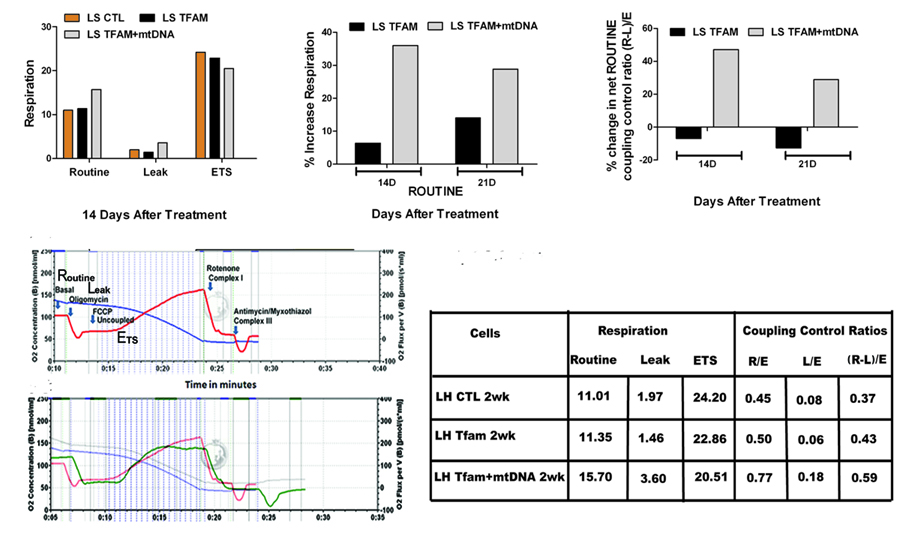Difference between revisions of "Iyer 2012 Abstract Bioblast"
Iyer Shilpa (talk | contribs) |
Iyer Shilpa (talk | contribs) |
||
| Line 12: | Line 12: | ||
We have developed a novel approach that uses a recombinant mitochondrial transcription factor A protein (rhTFAM) for external manipulation of the mitochondrial genome present inside cells. In the context of developing relevant cell-based models for targeted drug discovery, we have used this approach to introduce, replicate, and transcribe pathogenic mtDNA in human neural progenitor stem cells, while maintaining multipotency and successful differentiation into neuronal lineage in the short term [http://www.news.vcu.edu/news/Researchers_Develop_Stem_CellBased_Models_for_Studying_Mitochondrial]. In parallel, we also used healthy mtDNA complexed with rhTFAM to transduce into the mitochondria of two classic mitochondrial diseases, as cell models for proof-of-principle studies toward conducting mitochondrial gene therapy in the future. We introduced healthy mtDNA first into the cytoplasmic hybrid (cybrid) cells containing platelets from an LHON patient and, subsequently, into primary skin fibroblasts obtained from an LS patient [http://www.pubapps.vcu.edu/news/news/Researchers_Study_and_Develop_Approach_to_Treat_Mitochondrial]. We showed that using healthy donor mtDNA circles complexed with rhTFAM improved respiration (Figure 1) and biogenesis in LS and LHON disease cell lines caused by different pathogenic mtDNA point mutations. Results from these ongoing studies will contribute to (a) patient- and cell- specific stem cell models for drug testing and (b) therapeutic approaches for improving respiration in patients suffering from these incurable mitochondrial disorders. | We have developed a novel approach that uses a recombinant mitochondrial transcription factor A protein (rhTFAM) for external manipulation of the mitochondrial genome present inside cells. In the context of developing relevant cell-based models for targeted drug discovery, we have used this approach to introduce, replicate, and transcribe pathogenic mtDNA in human neural progenitor stem cells, while maintaining multipotency and successful differentiation into neuronal lineage in the short term [http://www.news.vcu.edu/news/Researchers_Develop_Stem_CellBased_Models_for_Studying_Mitochondrial]. In parallel, we also used healthy mtDNA complexed with rhTFAM to transduce into the mitochondria of two classic mitochondrial diseases, as cell models for proof-of-principle studies toward conducting mitochondrial gene therapy in the future. We introduced healthy mtDNA first into the cytoplasmic hybrid (cybrid) cells containing platelets from an LHON patient and, subsequently, into primary skin fibroblasts obtained from an LS patient [http://www.pubapps.vcu.edu/news/news/Researchers_Study_and_Develop_Approach_to_Treat_Mitochondrial]. We showed that using healthy donor mtDNA circles complexed with rhTFAM improved respiration (Figure 1) and biogenesis in LS and LHON disease cell lines caused by different pathogenic mtDNA point mutations. Results from these ongoing studies will contribute to (a) patient- and cell- specific stem cell models for drug testing and (b) therapeutic approaches for improving respiration in patients suffering from these incurable mitochondrial disorders. | ||
|keywords=Mitochondrial disorders, Stem Cells, Protofection, Respiration | |keywords=Mitochondrial disorders, Stem Cells, Protofection, Respiration | ||
|mipnetlab=US VA Richmond Iyer S, US VA Richmond Bennett JP, | |mipnetlab=US VA Richmond Iyer S, US VA Richmond Bennett JP, AT Innsbruck Gnaiger E, | ||
|journal=Mitochondr Physiol Network | |journal=Mitochondr Physiol Network | ||
|articletype=Abstract | |articletype=Abstract | ||
Revision as of 00:47, 8 November 2012
| Iyer S (2012) Gentle Science in the real world of mitochondrial physiology and genetics. Mitochondr Physiol Network 17.12. |
Link: MiPNet17.12 Bioblast 2012 - Open Access
Iyer S (2012)
Event: Bioblast 2012
The business of science is often a rat-race as we are searching for solutions in isolated closed environments, with the goal of reaching the top in our respective research fields. But, as Mahatma Gandhi said, “There is more to life than increasing its speed”; and “In a gentle way, we can shape the world”. When we apply these guiding principles to our research endeavors towards generating solutions for incurable diseases, it leads to open research environments which could eventually become more collaborative, efficient, powerful and more gentle. Thus, Gentle Science aims to create a bridge between science and spirituality to better understand our own lives and to live in harmony within ourselves and with the universe around us. It is important that we practice the tenets of Gentle Science in the real world of mitochondrial physiology and genetic disorders. Our Gentle Science [1] approaches have been enriched by our interactions with educators, scientists, clinicians, entrepreneurs and the patient community suffering from incurable mitochondrial disorders.
Many of these disorders represent a large group of diseases with heterogeneous clinical and pathological expressions characterized by irrevocable damage and improper functions of specialized metabolically active cell types. Examples include classical mitochondriopathies, Leber’s hereditary Optic Neuropathy (LHON), Leigh’s syndrome (LS), Amyotrophic Lateral Sclerosis (ALS), Mitochondrial myopathy, encephalopathy, lactic acidosis and stroke (MELAS) syndrome, that affect children and adults. Mitochondrial DNA (MtDNA) mutations and deletions are often found in these disorders and contribute to a decline in mitochondrial energy function and diminished vigor in these disorders.
We have developed a novel approach that uses a recombinant mitochondrial transcription factor A protein (rhTFAM) for external manipulation of the mitochondrial genome present inside cells. In the context of developing relevant cell-based models for targeted drug discovery, we have used this approach to introduce, replicate, and transcribe pathogenic mtDNA in human neural progenitor stem cells, while maintaining multipotency and successful differentiation into neuronal lineage in the short term [2]. In parallel, we also used healthy mtDNA complexed with rhTFAM to transduce into the mitochondria of two classic mitochondrial diseases, as cell models for proof-of-principle studies toward conducting mitochondrial gene therapy in the future. We introduced healthy mtDNA first into the cytoplasmic hybrid (cybrid) cells containing platelets from an LHON patient and, subsequently, into primary skin fibroblasts obtained from an LS patient [3]. We showed that using healthy donor mtDNA circles complexed with rhTFAM improved respiration (Figure 1) and biogenesis in LS and LHON disease cell lines caused by different pathogenic mtDNA point mutations. Results from these ongoing studies will contribute to (a) patient- and cell- specific stem cell models for drug testing and (b) therapeutic approaches for improving respiration in patients suffering from these incurable mitochondrial disorders.
• Keywords: Mitochondrial disorders, Stem Cells, Protofection, Respiration
• O2k-Network Lab: US VA Richmond Iyer S, US VA Richmond Bennett JP, AT Innsbruck Gnaiger E
Labels:
Organism: Human
Tissue;cell: Fibroblast
Preparation: Intact Cell; Cultured; Primary"Intact Cell; Cultured; Primary" is not in the list (Intact organism, Intact organ, Permeabilized cells, Permeabilized tissue, Homogenate, Isolated mitochondria, SMP, Chloroplasts, Enzyme, Oxidase;biochemical oxidation, ...) of allowed values for the "Preparation" property.
Regulation: Mitochondrial Biogenesis; Mitochondrial Density"Mitochondrial Biogenesis; Mitochondrial Density" is not in the list (Aerobic glycolysis, ADP, ATP, ATP production, AMP, Calcium, Coupling efficiency;uncoupling, Cyt c, Flux control, Inhibitor, ...) of allowed values for the "Respiration and regulation" property. Coupling state: LEAK, ROUTINE, OXPHOS, ETS"ETS" is not in the list (LEAK, ROUTINE, OXPHOS, ET) of allowed values for the "Coupling states" property.
HRR: Oxygraph-2k
Affiliations and author contributions
• Iyer S, Xiao E, Alsayegh K, Eroshenko N, Riggs MJ, Bennett JP Jr, Rao RR. Mitochondrial gene replacement in human pluripotent stem cell-derived neural progenitors. Gene Therapy. 2012 May;19(5):469-75. [4]
• Iyer S, Bergquist K, Young K, Gnaiger E, Rao RR, Bennett JP Jr. Mitochondrial gene therapy improves respiration, biogenesis, and transcription in G11778A Leber's hereditary optic neuropathy and T8993G Leigh's syndrome cells. Human Gene Therapy. 2012 Jun;23(6):647-57. [5]
Figure 1
Figure 1: Mitochondrial gene therapy improves respiration in Leigh's patient fibroblasts carrying T8993G mutation (see Iyer et al., Human Gene Therapy, 2012 for details).

